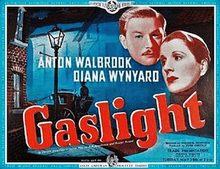Gaslight (1940 film)
| Gaslight | |
|---|---|
 Pre-release poster for trade showing | |
| Directed by | Thorold Dickinson |
| Produced by | John Corfield |
| Written by |
A. R. Rawlinson Bridget Boland |
| Based on |
Gas Light 1938 play by Patrick Hamilton |
| Starring |
Anton Walbrook Diana Wynyard |
| Music by | Richard Addinsell |
| Cinematography | Bernard Knowles |
| Edited by | Sidney Cole |
Production company | |
| Distributed by | Anglo-American Film Corp. (UK) |
Release dates |
|
Running time | 89 minutes[1] |
| Country | United Kingdom |
| Language | English |
Gaslight is a 1940 British film directed by Thorold Dickinson which stars Anton Walbrook and Diana Wynyard, and features Frank Pettingell. The film adheres more closely to the original play upon which it is based – Patrick Hamilton's Gas Light (1938) – than the better-known 1944 MGM adaptation. The play had been shown on Broadway as Angel Street,[2] so when the film was released in the United States it was given the same name.
Plot
Alice Barlow (Marie Wright) is murdered by an unknown man, who then ransacks her house, looking for her valuable and famous rubies. The house remains empty for years, until newlyweds Paul and Bella Mallen move in. Bella (Diana Wynyard) soon finds herself misplacing small objects; and, before long, Paul (Anton Walbrook) has her believing she is losing her sanity. B. G. Rough (Frank Pettingell), a former detective involved in the original murder investigation, immediately suspects him of Alice Barlow's murder.
Paul uses the gas lamps to search the closed off upper floors, which causes the rest of the lamps in the house to dim slightly. When Bella comments on the lights' dimming, he tells her she is imagining things. Bella is persuaded she is hearing noises, unaware that Paul enters the upper floors from the house next door. The sinister interpretation of the change in light levels is part of a larger pattern of deception to which Bella is subjected. It is revealed Paul is a bigamist. He is the wanted Louis Bauer, who has returned to the house to search for the rubies he was unable to find after the murder.
Cast
|
|
Reception
Encouraged by the success of the play and film, MGM bought the remake rights, but with a clause insisting that all existing prints of Dickinson's version be destroyed,[3] even to the point of trying to destroy the negative, so that it would not compete with their more highly publicised 1944 remake starring Charles Boyer, Ingrid Bergman, and Joseph Cotten.[4][5]
The Time Out critic wrote, "Nothing like as lavish as the later MGM version ... But in its own small-scale way a superior film by far. Lurking menace hangs in the air like a fog, the atmosphere is electric, and Wynyard suffers exquisitely as she struggles to keep dementia at bay. It's hardly surprising that MGM tried to destroy the negative of this version when they made their own five years later." [6]
Gaslight as expression
The psychological term gaslighting, which describes a form of psychological abuse in which the victim is gradually manipulated into doubting his or her own reality, originated from the play and its two film adaptations.[7] Gaslighting, today, mostly refers to one of the methods of abuse used by a narcissist to emotionally control a victim, through which the narcissist gains pleasure.
References
- Notes
- ↑ BBFC: Gaslight (1940) Linked 2014-03-08
- ↑ Angel Street on IBDB.com
- ↑ Brown, Geoff (2003–14). "Dickinson, Thorold (1903–1984)". BFI Screenonline. Retrieved 22 April 2014.
- ↑ Fristoe, Roger. "Gaslight (1940)" on TCM.com
- ↑ Horne, Philip (4 October 2008). "Thorold Dickinson's 1949 film The Queen of Spades has been called 'a masterpiece' by Martin Scorsese – so why is his work not better known?". The Guardian. London. Retrieved 30 May 2009.
- ↑ "Gaslight". Time Out. Retrieved 30 July 2016.
- ↑ Rush, Florence (February 1992). The best-kept secret: sexual abuse of children. Human Services Institute. p. 81. ISBN 978-0-8306-3907-6. Retrieved 16 June 2011.
- Bibliography
- Vermilye, Jerry. The Great British Films Citadel Press, 1978. pp. 52–54. ISBN 0-8065-0661-X
External links
- Gaslight at the Internet Movie Database
- Gaslight at the TCM Movie Database
- Gaslight at Rotten Tomatoes